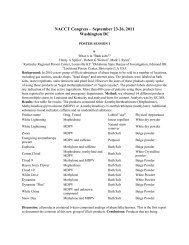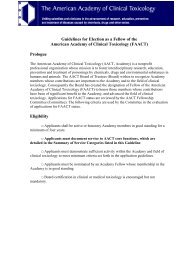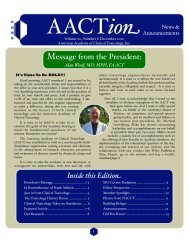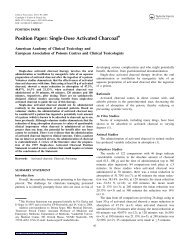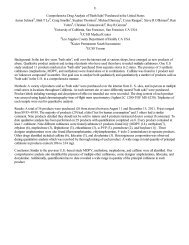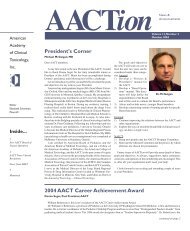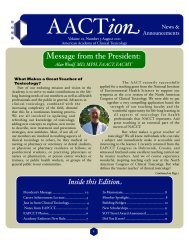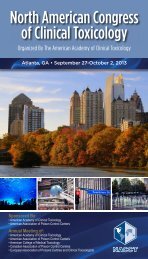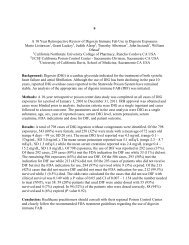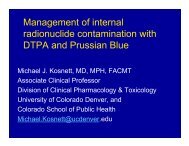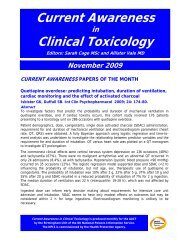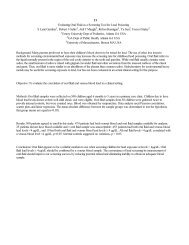Posters IV - The American Academy of Clinical Toxicology
Posters IV - The American Academy of Clinical Toxicology
Posters IV - The American Academy of Clinical Toxicology
Create successful ePaper yourself
Turn your PDF publications into a flip-book with our unique Google optimized e-Paper software.
(age>=18). Using artificial neural networks, decision tree induction, and logistic regression, we<br />
induced multiple possible predictive models <strong>of</strong> adherence for the three age groups using: only<br />
NPDS data elements, and combined NPDS data elements/narrative text. We validated models<br />
using one year <strong>of</strong> reserved data. We calculated non-parametric area under the receiver operating<br />
characteristic curve (AROC) for model comparison. Results: AROC values for predictive models<br />
based on NPDS data elements ranged from 0.64-0.71. AROC values for predictive models based<br />
on both NPDS data elements and narrative text ranged from 0.53-0.73. For 11 <strong>of</strong> 14 models, the<br />
inclusion <strong>of</strong> narrative text resulted in increased performance. <strong>The</strong> mean difference in AROC =<br />
0.02. Conclusions: Coded representations <strong>of</strong> narrative text improved the performance <strong>of</strong><br />
predictive models <strong>of</strong> caller adherence to PCC referral to EDs. <strong>The</strong> NPDS data elements<br />
accurately described key caller and exposure characteristics, and so the narrative text may reflect<br />
additional PCC staff concerns and impressions resulting from the communication process. In<br />
clinical decision support applications, PCCs should consider the modest improvement in<br />
predictive modeling realized with additional natural language processing in the context <strong>of</strong> clinical<br />
implications and increased processing times necessary to include narrative text in computerized<br />
decision support tools.<br />
264<br />
Exotic Venomous Snakebite Drill<br />
Rittirak Othong 1 , Sophia Sheikh 1 , Nahar D Alruwaili 1 , Rachel Gorodetsky 2 , Brent W Morgan 1 , Brad<br />
Lock 3 , Ziad N Kazzi 1<br />
1 Emory University, Atlanta GA 2 Georgia Poison Center, Atlanta GA 3 Zoo Atlanta, Atlanta GA USA<br />
Background: <strong>The</strong> National Poison Data System has reported 41-93 patients/year exposed to exotic<br />
venomous snakes from 2005 to 2009. According to the Association <strong>of</strong> Zoos and Aquariums'<br />
recommendation, institutions housing venomous animals should have protocols in place for appropriate<br />
and timely transport <strong>of</strong> envenomated individuals to hospitals. <strong>The</strong> objective <strong>of</strong> this study was to use a<br />
functional exercise to evaluate the existing exotic snakebite protocol (ESP) that is used by our local zoo.<br />
Methods: Prior to the exercise, all involved parties were contacted, including the poison center (PC), zoo,<br />
emergency medical services (EMS), receiving hospital emergency department (ED) and pharmacy. A<br />
checklist <strong>of</strong> all required actions in the ESP was created and used during the exercise. <strong>The</strong> exercise was<br />
divided into 4 phases that were evaluated by independent observers: zoo, EMS, PC, and hospital ED. <strong>The</strong><br />
zoo component was further divided into 3 action lists (victim, assistant, and zoo dispatch). After the drill,<br />
we held a debriefing session and generated an after action report that was submitted to the zoo, PC, and<br />
hospital administrations. Results: We found that the ESP contained procedures for zoo personnel that<br />
were easy to follow, but the procedures for hospital personnel lacked details regarding signs and<br />
symptoms expected from each species; indications, dosing, reconstituting and forms (liquid vs. powder) <strong>of</strong><br />
each antivenin (AV). Zoo personnel performed almost all required actions (93%-victim, 100%-assistant,<br />
93%-zoo dispatch). EMS and ED personnel completed 90% and 78% <strong>of</strong> the listed tasks while<br />
PC personnel completed 25% <strong>of</strong> the tasks. Additionally, we discovered that pharmacy was not included in<br />
the ESP, even though reconstituting and dosing the exotic AV consumed time (22 minutes). Finally, we<br />
encountered problems communicating the ESP to the ED and pharmacy due to the PC phone system<br />
problem. Despite the identified shortcomings, the time from simulated envenomation to AV<br />
administration was under an hour. Conclusions: This drill identified several potential issues that led us to<br />
revise our protocol by adding signs and symptoms expected from each species; indications, dosing and<br />
reconstituting <strong>of</strong> each AV; and a pharmacy section. We also identified suboptimal PC response in the



